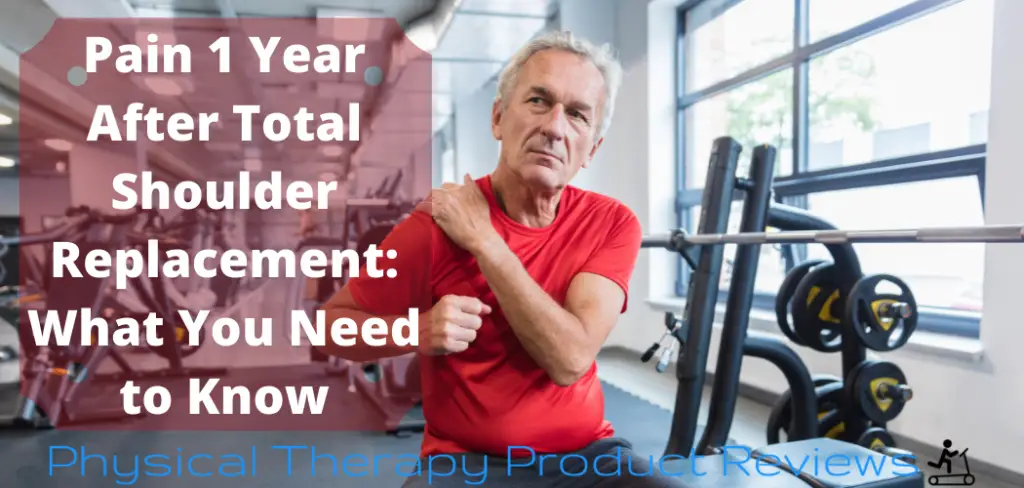Pain 1 year after total shoulder replacement can be tough, but it is important to know what pain is normal and what pain isn’t.
 Once you have surgery, the expectation is that the pain and limitation are fixed and should be working perfectly. It can be frustrating when your shoulder doesn’t progress after surgery the way you anticipated.
Once you have surgery, the expectation is that the pain and limitation are fixed and should be working perfectly. It can be frustrating when your shoulder doesn’t progress after surgery the way you anticipated.
This blog post will go over pain one year after a total shoulder replacement as well as how to manage pain 1-year post-surgery. It includes information about when you should see the doctor if you are experiencing pain that doesn’t improve or gets worse.
Is Pain 1 Year after a Total Shoulder Replacement Normal?
Pain 1 year after a shoulder replacement is normal for some people. The majority of people do not experience pain 1 year after surgery but it is more common than you might anticipate.
Patients often experience pain immediately following the surgery and may be prescribed pain medication to help manage this pain. Along with medication, you will go through an extensive course of physical therapy to help manage the pain, improve your range of motion, and improve your strength as your shoulder heals.
However, up to 22% of patients who had a total shoulder replacement still have considerable pain at 1 year from surgery. That means that 1-in-5 people who have a shoulder replacement are still having pain a full 12 weeks after surgery.
The prevalence of pain was higher for those that had a total shoulder replacement due to an injury like a fractured humerus at 29% as compared to only 16% for those with degenerative osteoarthritis.
Pro Tip: If you are still having pain 1 year after surgery, don’t panic as many other people are in the same boat. Let’s see if we can figure out what the primary cause of pain is and try to fix it.
Why Does my Shoulder Hurt 1 Year after a Shoulder Replacement?
There are many different reasons why pain 1 year after a shoulder replacement may occur. Some of the reasons can be fixed well beyond normal recovery timelines and some may need further medical intervention.
Pain that Wasn’t Well Controlled Early in Recovery
There is a high correlation between patients that had high levels of pain early in their recovery and those that had persistent pain beyond 2 years. This could mean that pain levels weren’t managed enough early on or that you did too much too fast causing pain and microtrauma to the surgery.
Higher Incidence with a Hemi-arthrosis or Implant
If you have a hemi-arthrosis or a partial shoulder replacement then you have a higher chance of pain 1 year or longer after surgery than someone who had a full total shoulder replacement.
Among other reasons, this can be due to the non-surgical side of the joint causing pain and progression of arthritis on the part of the joint that wasn’t replaced. You may have to have a full total shoulder replacement in the future.
Complications During Surgery
Unfortunately, another common cause for pain after a total shoulder replacement is complications that occur during surgery. Some of the most common complications post-surgery are:
- Infection
- Glenoid and humeral component loosening
- Rotator cuff tear
- Periprosthetic fracture
- Nerve injury
Lack of Strength
Strength or the ability to move your arm around pain-free can be another reason for pain 1 year after surgery.
There is a high correlation between lack of strength and pain during recovery. Depending on how strong your shoulder was before surgery, gaining strength can take a long time to regain.

If you don’t have enough strength in the shoulder then when you try to lift your arm the muscle won’t be able to stabilize your joint properly.
Stress and Depression
This might be surprising to some but a great predictor of pain after shoulder surgery is if the patient has significant anxiety or depression.
High levels of stress and depression can affect the neurotransmitters in the nervous system. This imbalance causes the brain to interpret high levels of pain with normally non-painful activities.
What Can You Do to Decrease Pain 1 Year After a Shoulder Replacement
If pain 1 year after surgery is what you are experiencing then there are a few things that may help.
Physical Therapy and Exercises to Improve Strength
When pain persists despite following the post-op instructions, it’s time to see your physical therapist sooner rather than later. Your PT can create specific exercises for your pain while creating pain-free movement patterns.
Make sure that they do a true strength assessment and help you figure out pain-free ways to improve your strength at home.
Stress, anxiety, and depression can accumulate pain in the nervous system while physical therapy can help rewire this pain response to be less intense. Your PT should be able to offer some relief even if it’s just temporarily.
Pro Tip: Keep working on improving strength in the shoulder for up to 2 years before seeking any additional surgeries.
Surgery for Rotator Cuff Tears or Periprosthetic Fractures
If pain 1 year after shoulder surgery is due to a rotator cuff tear or periprosthetic fracture then you may need more than PT. Surgery can be done on the Glenoid and Humeral components of your total shoulder replacement to fix these issues if they are causing pain.

If you have a rotator cuff tear after a shoulder replacement you may also have to have surgery to repair the rotator cuff. This ensures that the joint replacement lasts as long as possible but you will need to recover from the rotator cuff surgery which can take up to 6 months.
Surgery for Nerve Injuries
If pain 1 year after shoulder surgery is due to a nerve injury then you may need further medical intervention. Surgery can be done to decompress nerves that are pinched.
If there are no obvious signs of nerve compression from the surgery, then giving the body time to recover is the best option. Unfortunately, nerves can take quite a long time to fully recover.
Use Conservative measures such as Bracing, Pain Cream, and Electrical TENS Units
Conservative pain management is sometimes beneficial to drop your pain levels lower but it may not completely take it away.
Electrical stimulation or TENS units can help lower the stimulus to the nervous system for short periods of time.
Pain creams can help decrease pain throughout the day or is a good option to help you sleep through the night.
Braces can also help stabilize the joint and therefore reduce pain in the shoulder. Shoulder braces can also help decrease muscle spasms and muscles that are too tight by letting them relax and not have to work so hard to stabilize the joint.
Conclusion
Pain 1 year after shoulder surgery is common and there are many things that can be done to help. Time, pain management measures, braces, and physical therapy all have a place in decreasing pain post-surgery. If non-conventional pain relief doesn’t work then further tests may be needed to figure out why the pain is still present.
Other Great Rehab Related Articles
How to Stay Active After Cervical Fractures: Expert Tips and Advice
Dealing with Painful Stairs After Ankle Replacement Surgery
Walking After a Total Ankle Replacement: Tips for a Successful Recovery
Exercises While Non-Weight Bearing After Ankle Replacement: Elevation, AROM, Leg Raises, and More
Ankle Pain with Stairs: Causes and Home Treatment Options
5 Common Mistakes You’re Making After an Ankle Sprain
Disclaimer: The information provided in this post is for educational purposes only. This is not a substitute for a medical appointment. Please refer to your physician before starting any exercise program.







